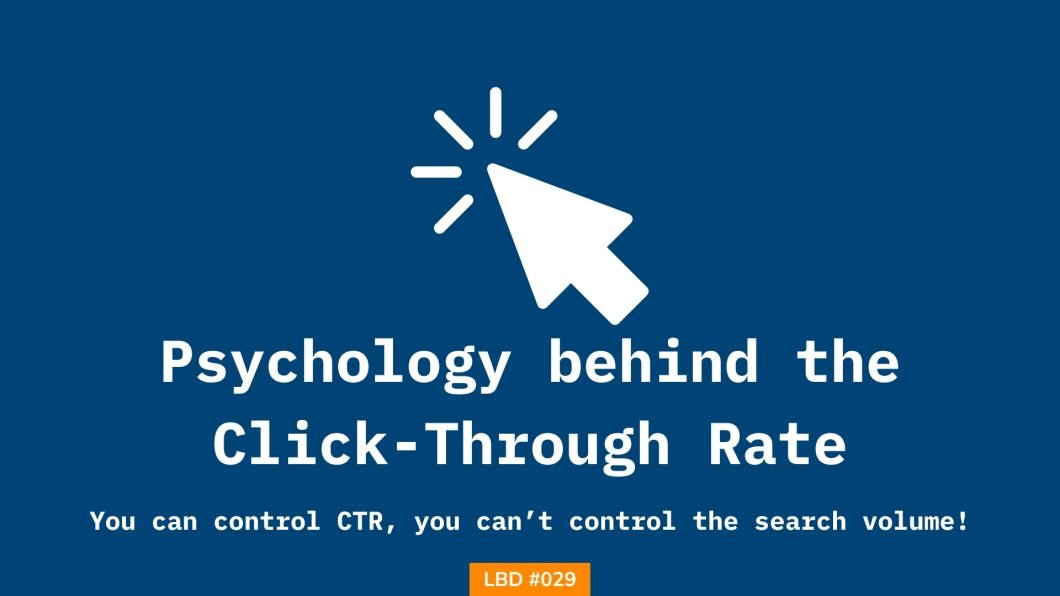Table of Contents
TL;DR & Summary
Are your click-through rates not as high as you’d like them to be? Learn the psychology behind it and discover 3 practical steps to improve your CTRs. Click through rate is more important than the search volume of the keywords you’re targeting. What good high search volume would do, if no one clicks on your link?
By the end of this issue, you will be able to understand how to improve your CTRs by:
- Understanding the psychology behind CTRs
- Crafting compelling headlines and descriptions
- Conducting A/B testing to improve CTRs
Do you feel like you’re not getting the results you want from your website? Low click-through rates might be the issue. In this issue, we’ll discuss the psychology behind click-through rates and provide practical steps to improve them.
Click-through rates are not only affected by the content of your website, but also by the psychological factors that influence user behavior.
We’ll dive into these factors and provide examples of how they impact click-through rates. Many people struggle with crafting headlines and descriptions that are both interesting and informative.
We’ll discuss how to write headlines and descriptions that grab attention and encourage users to click through to your website. A/B testing is an effective way to improve click-through rates.
Primary reason why improving CTRs is important
Low click-through rates can negatively impact your website’s visibility and traffic. By improving your click-through rates, you can increase traffic to your website and improve its overall performance. Some reasons why people struggle to improve their CTRs include not understanding the psychology behind it, lack of creativity in crafting headlines and descriptions, and not knowing how to conduct A/B testing.
Remember, improving your CTRs takes time and effort. However, with the right strategies in place, you can see significant improvements in your website’s performance.
- Improving CTRs can lead to more traffic: A higher click-through rate means more people are clicking on your content and visiting your website, which can ultimately result in more leads, conversions, and revenue.
- It can improve your search engine rankings: Click-through rate is a factor that search engines use to determine the relevance and quality of a webpage. If your CTRs are high, search engines may see your content as more valuable and rank it higher in search results.
- It can help you understand your audience: By analyzing your CTRs, you can gain insights into what types of content and messaging resonates with your audience. This can help you optimize your content and marketing strategies to better meet their needs and preferences.
Step 1: Understand the psychology behind CTRs
Understanding the psychology behind click-through rates is crucial to improving them. Explore the cognitive biases that impact user behavior and focus on how to leverage them to improve your click-through rates.
For example, the framing effect is a cognitive bias that influences the way people perceive information. By framing your headlines and descriptions in a way that appeals to the user’s emotions, you can increase the likelihood of them clicking through to your website.
Step 2: Craft compelling headlines and descriptions
Crafting headlines and descriptions that are both informative and interesting is key to improving your click-through rates. Write headlines and descriptions that grab attention and encourage users to click through to your website.
For example, using power words like “free,” “proven,” and “new” can make your headlines and descriptions more compelling. Additionally, using specific numbers or statistics can make your content more credible and trustworthy.
Step 3: Conduct A/B testing to improve CTRs
A/B testing is an effective way to improve click-through rates. Conduct A/B tests and analyzing the results to improve your click-through rates.
For example, you can test different headlines or descriptions to see which ones perform better. You can also test the placement of your call-to-action buttons or the colors of your website to see if they impact click-through rates.
Improving your click-through rates takes time and effort, but with the right strategies in place, you can see significant improvements in your website’s performance.
SEO this week (News Updates)
- How to use internal links for your content? Google updated the documentation.
Clickworthy resources (from LinkedIn, Twitter, YouTube & web)
- You can’t miss listening this gold mine. Do whatever you want, don’t miss listening to this podcast.
- YouTube’s priorities and initiatives for 2023, with a focus on creator growth, community safety, and innovation – Letter from Neal.
- Built knowledge base in Notion & Chatbot using Langchain
Tools that you should know about
- Test and Start – Test & validate business ideas
- Prompt Vibes – List of Prompts never seen before for ChatGPT
Surf the AI Wave
- Snapchat has started playing with AI, My AI. Available for Snapchat+ subscribers.
- Text to video is here! The Gen2 launch is mind blowing. (Gen2 Official website)
If you’re looking forward to winning online, here’s how I can help:
- Sit with you 1-on-1 & create a content marketing strategy for your startup. Hire me for paid consulting.
- Write blogs, social posts, and emails for you. Get in touch here with queries (Please mention you found this email in the newsletter to get noticed quickly)
- Join my tribe on Twitter where I share SEO tips (every single day) & teaser of the next issue of Letters ByDavey.

